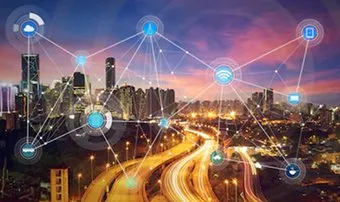The Internet of Things : Beyond the Hype
Blog: NASSCOM Official Blog

IoT seems to have crossed its Hype Cycle peak somewhere in 2016 and is well heading into the Troughs of Despair. The ubiquitous IOT device still remains the mobile phone with people preferring to use more of the integrated sensors in mobiles rather than discrete sensors. It was not surprising to find that the major IOT conferences in 2017 devoted a good amount of time to businesses based on mobile applications like ride hailing apps and fleet management apps.
One common impediment to IOT proliferation to the extent predicted is the lack of adoption of any of the standards to the extent predicted. Radio standards have been pitched one against the other ranging from BLE, Zigbee, 6LowPan, LoRa and very recently NB-IoT and LTE-M1. Security threats in IoT networks still remains a problem whose solution is work in progress. Much needs to be done to ensure IoT networks meet the reliability norms in mission critical applications.
However, chasing proliferation of any single standard in IoT applications is more likely to be like chasing a pipe dream. This is because the ‘T’ in IoT is so diverse that same size does not fit all. The diversity of Things can be classified based on the following characteristics to truly understand why.
Value of the Thing: – Human Health is deemed most valuable. So, pedometers, health trackers etc. would keep selling. More so, if it is integrated into a mobile phone and presented as an application. High value asset tracking including tracking vehicles in fleet management services and ride hailing services is also intrinsically valuable, but the value would need to be factored in as the value of efficiencies achieved due to faster tracking and not really the original value of the item. As the value of the Thing increases the propensity to spend on an IoT device also increases. The onus would then be on better accuracy and security rather than the cost of the device. However, a street lighting automation IoT project would need to ensure that the cost of the device is extremely small or at least the energy saving could be clearly articulated to justify the need for deployment. Typically, the IoT device should not cost more than 1-3% of the cost of the item it would be attached to.
Data Intensity of the Thing: – The amount of distinct and valuable data that the sensor generates also determines the type of IoT connectivity required. The GPS of a ride-hailing app would need a faster radio connectivity like 3G or 4G. A street lighting control IoT product might only require a low bandwidth but high range connectivity standard like NB-IoT or LoRa. Battery requirement over the lifetime also changes drastically with data intensity, thus requiring customization for the IoT device based on intensity.
The Thing’s environment: – There are many factors in the environment of a thing that should be taken into cognisance before deciding the suitable technology.
- With a cluttered 2.4GHz band in airports, railway stations, hospitals, exhibitions etc your IOT project based on BLE or WiFi is more likely than not to experience failures. A more robust/less cluttered RF technology like UWB might need to be explored in such scenarios. Similarly, in rural areas where mobile connectivity is sparse, redundancy mechanisms like SMS need to be built in if the basic IOT gateway is a mobile phone.
- A container yard which could have large amounts of metallic containers is more likely than not to give you surprises with respect to range and basic connectivity, if you try to use Gigahertz radio frequencies. Some Sub Gigahertz technology is likely to fare much better. Similar is the case with Metro Railway projects, where large sections run under the ground.
- Indoor vs Outdoor is also a key determining factor. GPS sensors work well for positioning outdoors. For Indoors it would be better to go for a beacon based approach
- Harshness of the environment is also a key determinant. An outdoor device would surely need to be IP67 or IP68. Industrial IoT devices would need to withstand wider ranges of temperature variation
Cost of Failure of the Thing: – What makes the street lighting IoT project challenging, apart from the need to have a low-cost device is the high cost of failure of the project. It would be a truly unpleasant experience if a hacker could intrude into the network and cause all street lights to be permanently off. Security therefore becomes a major concern. Larger the network or larger the value of the asset, larger the cost of failure. Security becomes a major concern here, when compared to devices tracking individual things.
The Thing’s need for the Internet, rather than the Internet’s need for the Thing: – This I believe is by far the most important factor. Frivolous applications like tracking the temperature inside your fridge or switching on the Music player in your house before you reach your house exist. However other than for gadget freaks such applications make no sense. So, the key question in any IoT project to be asked is what is the efficiency and value that it brings in for a larger community.
IoT technologies would keep evolving with better features. However, at least a few of them would co-exist to meet the diverse needs of the real world. So, rather than wishing that the best player wins, let us wish a few good players co-exist and enable the diverse needs of a complex environment. A lot is therefore left on the table for solution architects who would need to be cognizant of the variety of tools that exist and choose the best for the particular need.
The post The Internet of Things : Beyond the Hype appeared first on NASSCOM Community |The Official Community of Indian IT Industry.
